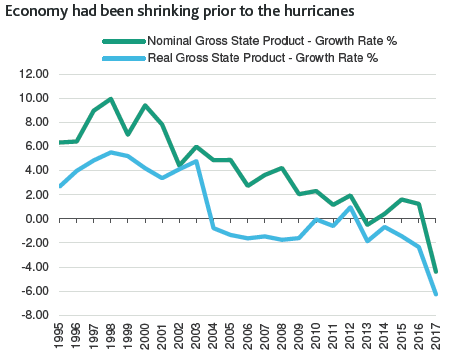Moody’s: P.R.’s economy will shrink 6-7% in ’18

Following a contraction of 6.2 percent in 2017, Moody’s Credit Standards and Strategy Group expects Puerto Rico’s economy to shrink by another 6 percent to 7 percent this year, with some rebound in the second half of the year, supported by rebuilding activity.
In the report, the credit ratings agency further noted that by the end of 2019, the island’s economy will be 5 percent smaller in real terms than it was before the back-to-back hurricanes that slammed Puerto Rico in September 2017.
“The combination of the island’s weak finances, extensive physical damage, accelerated outmigration, and fragile infrastructure puts it in a tenuous position,” the firm stated. “Our forecasts do not incorporate a significant boost from structural reforms envisaged in the various post-hurricane fiscal plans. Even if implemented, it remains to be seen whether these can meaningfully improve economic prospects in the near-term.”
Moody’s noted that different sectors of the economy face a diverse sets of challenges. The slow trickle in the arrival of federal assistance and the need to import labor and equipment are dampening those benefits.
“Federal Emergency Management Agency aid is traditionally a key element of disaster relief and recovery for U.S. states and local governments. We estimate that $33 billion in federal aid has been allocated to Puerto Rico, of which only a fraction has been paid out,” Moody’s noted.
“We attribute the slow pace of disbursement to several factors, including the large number of disaster areas, which may have dispersed deployment of relief efforts. Because of the island’s territory status, Puerto Rico’s representative in Congress cannot vote on final legislation, making advocacy on behalf of the island’s citizens more difficult,” it noted.
Puerto Rico’s history of unpermitted construction has also hampered disbursement of FEMA assistance to individuals. As of May 1, FEMA had reportedly received more than 1 million registrations for disaster assistance but denied 330,000 of them because of insufficient documentation.
“We expect federal assistance will likely have a lower multiplier effect than when deployed on the mainland and to more vibrant economies. This is because a large part of the federal aid money will not stay in the island, given labor and materials constraints,” Moody’s stated.
Significant manpower and equipment will need to be imported, with profit captured by mainland-based firms. In its latest fiscal plan for the commonwealth, the Financial Oversight and Management Board for Puerto Rico estimates that only 12.5 cents of every aid dollar will have a direct impact on the local economy.
Meanwhile, accelerated out-migration is also problematic for Puerto Rico’s recovery and long-term outlook. While 6 percent of the population left last year, adding to the annual out-migration of about 1.1 percent a year from 2006 to 2016.
“We expect more mobile and productive individuals to continue to leave Puerto Rico, exacerbating already unfavorable demographics. As of 2016, Puerto Rico had the third-highest share of individuals over 65 in the U.S. (18.9 percent) after Florida and Maine, and the lowest labor participation rate in the country at 40 percent, compared with nearly 63 percent nationally.














